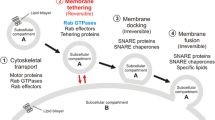Summary
Reconstituted cytochrome oxidase liposomes were fused with liposomes reconstituted with mitochondrial hydrophobic protein, which acts as a membrane-bound uncoupler of cytochrome oxidase. Fusion was assayed by the loss of respiratory control of cytochrome oxidase as measured by the increased rate of ascorbate oxidation induced by hydrophobic protein when both proteins shared the same vesicles. Fusion was dependent on the presence of phosphatidylserine in the liposomes and Ca++ in the aqueous medium. Phosphatidylcholine-phosphatidylserine liposomes required higher concentrations of phosphatidylserine and Ca++ than did phosphatidylethanolamine-phosphatidylserine liposomes. Cytochrome oxidase vesicles containing high concentrations of phosphatidylserine showed little or no respiratory control, while those with lower concentrations showed high respiratory control; respiratory control could be induced by fusing cytochrome oxidase vesicles containing high phosphatidylserine with protein-free liposomes containing low phosphatidylserine concentration. If cytochrome oxidase vesicles and hydrophobic protein vesicles were prefused separately for 15 min, they lost the ability to fuse upon being subsequently mixed together. The reconstituted vesicles had diameters of about 200 Å; fusion yielded vesicles with diameters in excess of 1000 Å.
Similar content being viewed by others
References
Eytan, G., Carrol, R.C., Schatz, G., Racker, E. 1975. Arrangement of the subunits in solubilized and membrane-bound cytochromec oxidase from bovine heart.J. Biol. Chem. 250:8598
Galla, H.-J., Sackmann, E. 1975. Chemically induced lipid phase separation in model membranes containing charged lipids: A spin label study.Biochim. Biophys. Acta 401:509
Gent, M.P.N., Prestegard, J.H. 1974. Cholesterol-phosphatidylcholine interactions in vesicle systems. Implication of vesicle size and proton magnetic resonance line-width changes.Biochemistry 13:4027
Hinkle, P.C., Kim, J.J., Racker, E. 1972. Ion transport and respiratory control in vesicles formed from cytochrome oxidase and phospholipids.J. Biol. Chem. 247:1338
Hopper, V., Lehninger, A.L., Thompson, T.E. 1968. Protonic conductance across phospholipid bilayer membranes induced by uncoupling agents for oxidative phosphorylation.Proc. Nat. Acad. Sci. U.S.A. 59:484
Ito, T., Ohnishi, S., Ishinaga, M., Kito, M. 1975. Synthesis of a new phosphatidylserine spin-label and calcium-induced lateral phase separation in phosphatidylserine-phosphatidylcholine membranes.Biochemistry 14:3064
Jacobson, K., Papahadjopoulos, D. 1975. Phase transitions and phase separations in phospholipid membranes induced by changes in temperature, pH, and concentration of bivalent cations.Biochemistry 14:152
Kagawa, Y., Kandrach, A., Racker, E. 1972. Partial resolution of the enzymes catalyzing oxidative phosphorylation. XXVI. Specificity of phospholipids required for energy transfer reactions.J. Biol. Chem. 248:676
Kagawa, Y., Racker, E. 1966. Partial resolution of the enzymes catalyzing oxidative phosphorylation. IX. Reconstruction of oligomycin-sensitive adenosine triphosphatase.J. Biol. Chem. 241:2467
Kagawa, Y., Racker, E., 1971. Partial resolution of the enzymes catalyzing oxidative phosphorylation. XXV. Reconstitution of particles catalyzing32Pi-adenosine triphosphate exchange.J. Biol. Chem. 246:5477
Kantor, H.H., Prestegard, J.H. 1975. Fusion of fatty acid containing lecithin vesicles.Biochemistry 14:1790
Katz, B. 1969. The Release of Neural Transmitter Substances. Thomas, Springfield, Illinois
Lau, A.L.Y., Chan, S.I. 1974. Nuclear magnetic resonance studies of the interaction of alamethicin with lecithin bilayers.Biochemistry 13:4942
Maeda, T., Ohnishi, S.I. 1974. Membrane fusion transfer of phospholipid molecules between phospholipid bilayer membranes.Biochem. Biophys. Res. Commun. 60:1509
Miledi, R. 1973. Transmitter release induced by injection of calcium ions into nerve terminals.Proc. Roy. Soc. B London 183:421
Mitchell, P. 1966. Chemiosmotic Coupling in Oxidative and Photosynthetic Phosphorylation. Glynn Research Ltd., Bodmin, Cornwall, England
Mitchell, P. 1967. Proton translocation and phosphorylation in mitochondria, chloroplasts, and bacteria: Natural fuel cells and solar cells.Fed. Proc. 26:1370
Mitchell, P., Moyle, J. 1967. Acid-base titration across the membrane system of rat-liver mitochondria.Biochem. J. 104:588
Mueller, P., Rudin, D.O. 1969. Translocators in bimolecular lipid membranes and their role in dissipative and conservative bioenergy transductions.In: Current Topics in Bioenergetics. D.R. Sanadi, editor. Vol. 3, p. 157. Academic Press, N.Y.
Ohnishi, S., Ito, T. 1974. Calcium-induced phase separation in phosphatidylserinephosphatidylcholine membranes.Biochemistry 13:881
Papahadjopoulos, D., Miller, N. 1967. Phospholipid model membranes. I. Structural characteristics of hydrated liquid crystals.Biochim. Biophys. Acta 135:624
Papahadjopoulos, D., Poste, G., Schaeffer, D.E., Vail, W.J. 1974. Membrane fusion and molecular segregation in phospholipid vesiclesBiochim. Biophys. Acta 325:10
Prestegard, J.H., Fellmeth, B. 1974. Fusion of dimyristoyllecithin vesicles as studied by proton magnetic resonance spectroscopy.Biochemistry 13:1122
Racker, E. 1972. Reconstitution of cytochrome oxidase vesicles and conferral of sensitivity to energy Transfer inhibitors.J. Membrane Biol. 10:221
Racker, E. 1974. Mechanism of ATP formation in mitochondria and ion pumps.In: Dynamics of Energy Transducing Membranes. L. Ernster, R.W. Estabrook and E.C. Slater, editors. p. 269. Elsevier, Amsterdam
Racker, E. 1975. Reconstitution of membranes.In: Tenth FEBS Meeting J. Montreuil and P. Mandel, editors. Vol. 41, p. 25. North-Holland/American Elsevier, New York
Racker, E., Chien, T.-F., Kandrach, A. 1975. A cholate dilution procedure for the reconstitution of the Ca++ pump,32Pi-ATP exchange, and oxidative phosphorylation.FEBS Letters 57:14
Yonetani, T. 1967. Cytochrome oxidase: Beef heart.Methods enzymol. 10:332
Author information
Authors and Affiliations
Rights and permissions
About this article
Cite this article
Miller, C., Racker, E. Fusion of phospholipid vesicles reconstituted with cytochromec oxidase and mitochondrial hydrophobic protein. J. Membrain Biol. 26, 319–333 (1976). https://doi.org/10.1007/BF01868880
Received:
Issue Date:
DOI: https://doi.org/10.1007/BF01868880




